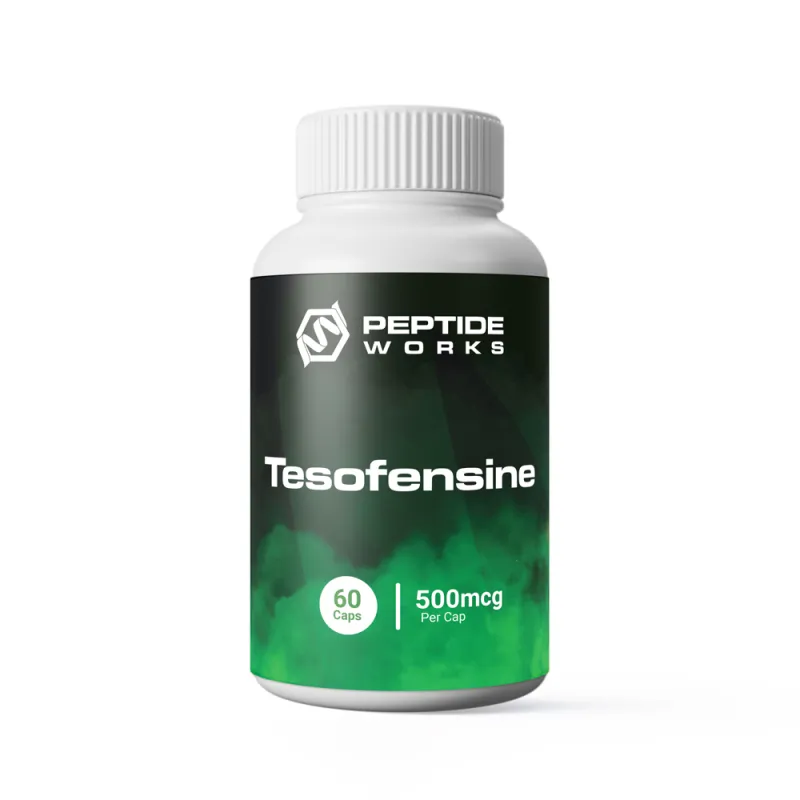
PROMO!
First order? Get 10% OFF with this code: 1storder
Written by

Belly fat is one of the most stubborn areas of fat storage. It has become a major focus in scientific studies. Researchers are especially interested in Tesamorelin. It is a peptide made of short chains of amino acids that works by stimulating growth hormone activity. This process has been linked with reductions in visceral adipose tissue, the deep fat surrounding abdominal organs that is often the hardest to reduce. Because of this, it is often studied in research exploring peptide therapy for belly fat.
What makes Tesamorelin stand out in fat reduction research is its targeted effect. It does not focus on overall body weight. Studies suggest it can influence where fat is stored and how the body’s ability to regulate energy balance changes over time. For this reason, Tesamorelin is frequently explored as a potential fat reducing peptide. It shows distinct benefits compared to other approaches.
Because of these promising results, researchers continue to study how Tesamorelin works as a fat reducing peptide, focusing on IGF-1, hormone levels, and metabolic processes related to fat metabolism.
Explore Tesamorelin from Peptide Works, a growth hormone–releasing peptide that targets visceral belly fat and supports healthy fat metabolism.

Tesamorelin is a growth hormone–releasing hormone analogue. It binds to receptors in the pituitary gland and stimulates the release of growth hormone. This action raises IGF-1 levels, which play a role in fat breakdown. Research suggests that this pathway promotes lipolysis, the process by which fat cells release fatty acids for energy. Because visceral adipose tissue is more metabolically active than surface fat, trials often show the effect most strongly in deep belly fat, making Tesamorelin one of the most studied peptides to reduce visceral fat.
Studies also note improvements in lipid metabolism when Tesamorelin is used in research settings. Triglyceride levels tend to drop, while adiponectin a hormone that helps regulate fat storage rises. These combined shifts improve the way energy is used and fat is stored. That’s why Tesamorelin is often highlighted as a fat reducing peptide with notable activity against visceral fat compared to other methods.
Researchers have also examined why visceral fat appears to respond more strongly to Tesamorelin than other fat depots.
Visceral adipose tissue reacts strongly to hormone signals because it has greater blood flow and more receptors for growth hormone activity. When Tesamorelin, a growth hormone-releasing hormone analogue, raises IGF-1 levels, these receptors respond quickly. In clinical studies, this makes VAT reduction more pronounced than changes in subcutaneous fat. Researchers often point to this depot-specific sensitivity when explaining why abdominal fat loss is consistent in Tesamorelin studies.
VAT is also tied to metabolic health. It produces cytokines that affect insulin sensitivity, lipid profiles, and energy balance. Trials show Tesamorelin lowers triglycerides and raises adiponectin, two important markers of fat distribution and metabolism. These changes highlight why visceral fat responds faster and why Tesamorelin is studied as a leading fat reducing peptide in this context.
Beyond response differences, research has also looked at how Tesamorelin changes fat distribution across the body.

Research shows Tesamorelin shifts fat distribution rather than causing general weight loss. The most consistent change is a clear reduction in visceral adipose tissue, while subcutaneous fat remains mostly unchanged. This selective action helps reduce the deep belly fat linked with higher metabolic risk. Some studies also note modest drops in liver fat, adding another layer of benefit to its profile.
Tesamorelin also improves fat quality. By increasing adipocyte density, fat tissue becomes healthier and more effective at managing lipids and energy. These improvements reshape body composition in ways that extend beyond the scale. For this reason, Tesamorelin is often described as a peptide for fat loss with distinct effects compared to compounds like Tesofensine, which act more on appetite and energy control.
Another fat reducing peptide frequently studied is Tesofensine, which uses a completely different approach. While Tesamorelin works through hormone pathways, Tesofensine influences fat loss through appetite and energy balance.
Tesofensine is often discussed in fat reduction research because it affects both hunger and calorie use. It acts as a monoamine reuptake inhibitor, keeping serotonin, norepinephrine, and dopamine active in the brain. These chemicals control satiety and motivation. When their signals last longer, cravings drop and meals feel more filling. This appetite control is one reason Tesofensine is studied as a potential peptide for weight reduction.
Some studies suggest Tesofensine modestly raises resting energy expenditure, meaning the body may burn slightly more calories even while at rest. This mix of reduced intake and modestly higher burn makes its effect on body composition different from peptides like Tesamorelin, which work through hormone pathways.
Beyond appetite regulation, Tesofensine has also been studied for its possible benefits outside fat reduction.
Discover Tesofensine from Peptide Works, a peptide that modulates appetite and energy expenditure to promote overall body weight reduction while preserving lean mass.

Tesofensine is studied as a fat reducing peptide, but its role reaches beyond trimming body fat. Clinical research links it with better metabolic health, including lower triglycerides, healthier cholesterol levels, and improved blood sugar control. These changes show Tesofensine may influence the wider network of energy balance, not just appetite and weight.
Another advantage suggested in trials is relative muscle preservation. While body fat decreases, lean mass often remains more stable compared to some other weight-loss approaches. This dual effect, reducing stored stubborn fat while protecting muscle, sets Tesofensine apart from many weight-loss methods and highlights its potential value in ongoing peptide research.
With these differences in mind, it becomes useful to compare Tesamorelin and Tesofensine as fat reducing peptides directly.
Tesamorelin and Tesofensine are both studied as fat reducing peptides, but they work in very different ways. Tesamorelin acts on growth hormone pathways, making it effective at lowering visceral belly fat. Research shows it reduces deep abdominal fat while leaving subcutaneous fat largely unchanged, which highlights its crucial role as a fat reducing peptide focused on visceral fat.
Tesofensine works through neurotransmitter reuptake inhibition. By suppressing appetite and modestly raising energy use, it produces greater overall weight loss in trials. It also helps preserve lean muscle mass, giving it a body-composition benefit. Based on separate studies, Tesamorelin appears more effective for reducing visceral belly fat, whereas Tesofensine shows significant weight loss effects. No head-to-head trials have directly compared the two. The following table summarizes their differences:
| Feature | Tesamorelin | Tesofensine |
|---|---|---|
| Main Target | Visceral belly fat | Overall body weight |
| Key Mechanism | Growth hormone → IGF-1 release | Neurotransmitter reuptake inhibition |
| Research Focus | Abdominal fat, metabolic markers | Appetite suppression, energy balance |
| Body Composition Effect | Reduces VAT, stable SAT | Relatively preserves lean mass, lowers fat mass |
These insights set the stage for where fat reducing peptide research may be heading in the future.
Research into fat reducing peptides like Tesamorelin and Tesofensine continues to grow. Studies are uncovering how these compounds influence fat distribution, metabolism, and body composition in ways that go beyond traditional weight-loss approaches. The future of this field lies in deeper insights into long-term outcomes, safety, and how these compounds can be used to better understand the biology of fat reduction.
Some studies also note that visceral fat can return after stopping Tesamorelin, suggesting its benefits may require ongoing treatment supported by a healthy diet and lifestyle change. This ongoing need for quality research materials drives continued scientific exploration.
At Peptide Works, we provide high-quality research peptides to scientists and institutions around the globe. Our goal is to support researchers as they explore new possibilities, helping drive progress in peptide science that may shape the future of fat reduction and metabolic health.
All products discussed are supplied for research purposes only and are not intended for human use.
[1] Stanley TL, Feldpausch MN, Oh J, Branch KL, et al. Effect of tesamorelin on visceral fat and liver fat in HIV-infected patients with abdominal fat accumulation: a randomized clinical trial. JAMA. 2014 Jul 23-30;312(4):380-9.
[2] Lake JE, La K, Erlandson KM, Adrian S, et al. Tesamorelin improves fat quality independent of changes in fat quantity. AIDS. 2021 Jul 15;35(9):1395-1402.
[3] Axel AM, Mikkelsen JD, Hansen HH. Tesofensine, a novel triple monoamine reuptake inhibitor, induces appetite suppression by indirect stimulation of alpha1 adrenoceptor and dopamine D1 receptor pathways in the diet-induced obese rat. Neuropsychopharmacology. 2010 Jun;35(7):1464-76.
[4] Sjödin A, Gasteyger C, Nielsen AL, Raben A, et al. The effect of the triple monoamine reuptake inhibitor tesofensine on energy metabolism and appetite in overweight and moderately obese men. Int J Obes (Lond). 2010 Nov;34(11):1634-43.
ALL CONTENT AND PRODUCT INFORMATION AVAILABLE ON THIS WEBSITE IS FOR EDUCATIONAL PURPOSES ONLY.
DISCLAIMER: These products are intended solely as a research chemical only. This classification allows for their use only for research development and laboratory studies. The information available on our Peptide Works website: https://peptide-works.com/ is provided for educational purposes only. These products are not for human or animal use or consumption in any manner. Handling of these products should be limited to suitably qualified professionals. They are not to be classified as a drug, food, cosmetic, or medicinal product and must not be mislabelled or used as such.
Peptide Works
Related Articles

How effective could Orexin Addiction Therapy be?
Have you ever wondered why some people find it so hard to stop addictive habits, even when they truly want

Can NAD Therapy Improve Cognitive Performance?
NAD Therapy is gaining attention in research for its possible role in brain health. NAD+ (nicotinamide adenine dinucleotide) is a

Enhancing Energy with NAD+ Supplements
Energy is the driving force behind focus, movement, and recovery. When cells have less energy to work with, the body